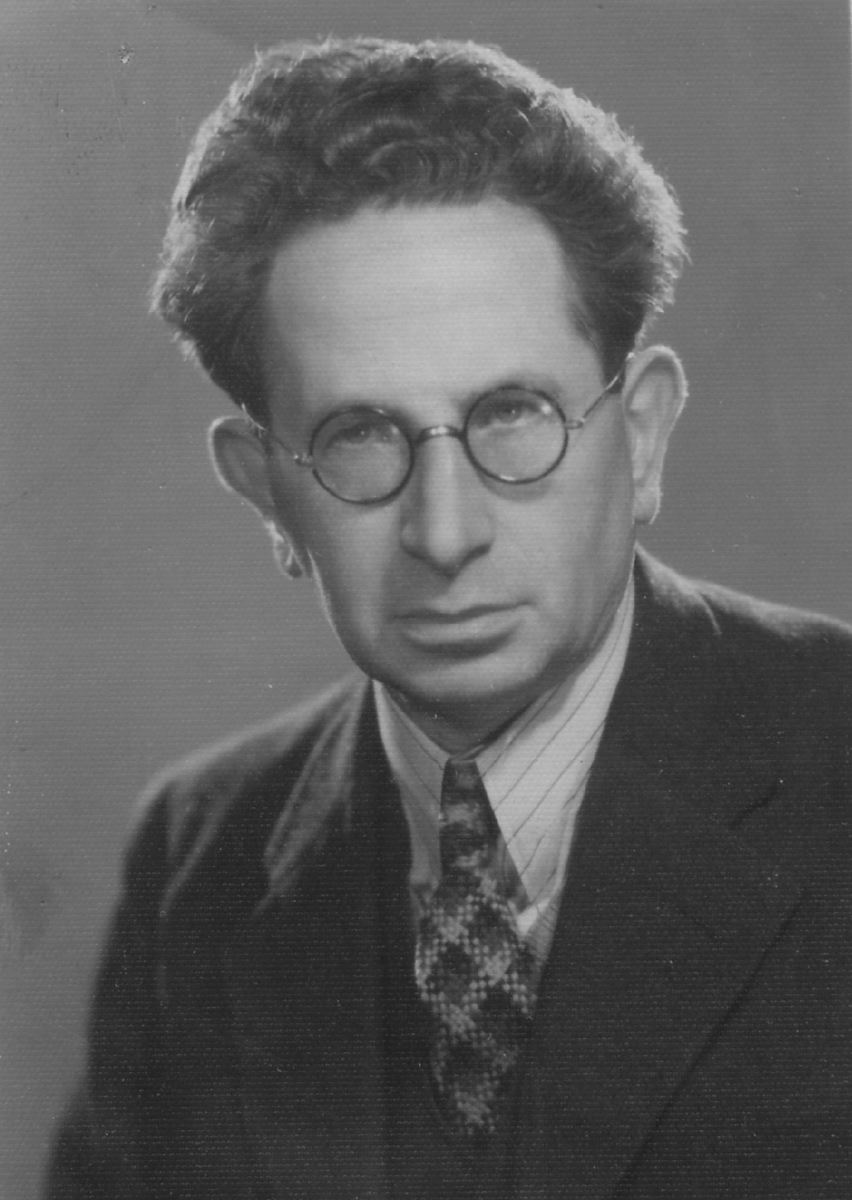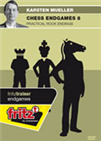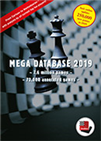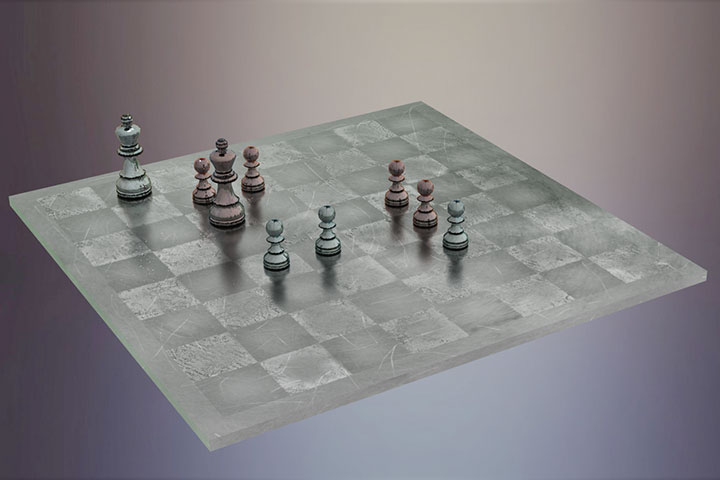Study of the Month: March 2019
Artur Mandler (sometimes written as “Arthur") was a prolific composer of moremovers and endgame studies, and is our protagonist this month. The great work of John Beasley has been used for this column before, and this practice is continued as the British master has written a book on Mandler, called Depth and Beauty, being essentially an English translation (and slight extension) of Mandler’s 1970 book Studie with permission by Mandler’s son. It was “Book of the Year 2003” of the Dutch endgame studies society ARVES.[1] In addition, John Beasley (via e-mail) sent once more the translated article from the Malá encyklopedie šachu.
 Mandler (pictured) was born on January 5th, 1891 in Czechoslovakia. The German Wikipedia entry originally written by Rainer Staudte gives the Czech city of Humpolec (medieval and 1939-1945 occupied name Gumpolds) as place of birth. According to Wikipedia, this small city in the middle of the Czech Republic had almost 11,000 inhabitants in 2018 but has a long history and was home of several personalities including the musical composer Gustav Mahler (born seven kilometres away in the small — likely countryside — village Kaliště) and the poet Felix Grafe.
Mandler (pictured) was born on January 5th, 1891 in Czechoslovakia. The German Wikipedia entry originally written by Rainer Staudte gives the Czech city of Humpolec (medieval and 1939-1945 occupied name Gumpolds) as place of birth. According to Wikipedia, this small city in the middle of the Czech Republic had almost 11,000 inhabitants in 2018 but has a long history and was home of several personalities including the musical composer Gustav Mahler (born seven kilometres away in the small — likely countryside — village Kaliště) and the poet Felix Grafe.
In EG 29, September 1972, Imre König recollected about Mandler in the 1920s:
He belonged to [...] the Viennese school when Vienna was the center of chess. [...] His closest friends were Réti and Feigl, whom he considered the greatest problemist alive at the time. He and his brother used to come to the Café Central.
Many of our readers will know that to be a cultural centre of chess at the time with many masters such as Spielmann and Tartakower regularly attending. Imre König from Hungary — at that time in Vienna but after restless decades in several countries eventually settling in Santa Monica, California — became co-author of two 1924 endgame studies by showing endgames from practical play in the Café Central which Mandler polished to their final form. One of the studies by König and Mandler is among my favorites (re-playable below), showing a fourfold echo (repeated pattern) of winning
a rook in an almost basic four rooks endgame.
Let us quickly go through the highlights of Mandler’s composing career. In 1956 he became an International Judge for Chess Composition. Ten years later, in 1966, Mandler received the title of International Master for Chess Composition, based on his FIDE Album entries, which gave him 97.17 points in total, enough for the Grandmaster title which was posthumously awarded in 2012. The Czechoslovakian authorities awarded him the ZMS title (translating to “Deserved Master of Sports”) in 1968.
Those titles stemmed from a productive and engaging life seeing Mandler as President of the Czechoslovakian Federation for Chess Composition 1953-1954, editor for the (still existing) Československý šach composition column 1954-1955 and FIDE Revue. He won more than 50 prizes for a total of over 600 compositions. Among those are more than 320 more-movers, which is the term used for checkmates in at least four moves, and over 220 endgame studies. Further included are several helpmate problems where both sides cooperate to checkmate Black, and chess problems that use a cylindrical chess board.

Cylindrical chess board | Photo: Serge clair [CC BY-SA 3.0] via Wikimedia Commons
On this non-standard board the edges of the board are connected, similar to how a cylinder has no end on its vertical plane. So the a-file is directly to the right of the h-file, while otherwise the normal chessboard geometry remains. Variations of this include a torus board where also the 8th and 1st rank directly connect, so long-range pieces such as the bishop can move in interesting geometrical patterns. In addition, Mandler sometimes used unusual sizes for chess boards, such as 8x7. Other sources give a different total for Mandler's lifetime output such as over 1,000 compositions (Wikipedia) or over 350 endgame studies (ARVES).
According to Beasley’s book, Mandler “had a mastery of the natural endgame study” comparable to Réti and Grigoriev. In EG 31, John Roycroft shortly characterized a short selection of Mandler’s works: They “demonstrate Mandler’s wide range, but even more his artistic tenets of the Bohemian school. Here is no depth for depth’s sake. Instead, subtlety, beauty and economy combine inextricably and inevitably, so it seems, into one glorious achievement.”
 Rook endings are amongst the most frequently encountered endgames there are, and so your training effort will be quickly repaid in the form of half and full points. Knowing even a few rules of thumb and key methods makes life a great deal easier and provides a guiding light even in complex positions. This DVD focuses on the important themes which are to be found in common rook endings.
Rook endings are amongst the most frequently encountered endgames there are, and so your training effort will be quickly repaid in the form of half and full points. Knowing even a few rules of thumb and key methods makes life a great deal easier and provides a guiding light even in complex positions. This DVD focuses on the important themes which are to be found in common rook endings.From what I see about Mandler’s endgame studies, many of his works are positions which could become relevant for practical play. We find rook endgames, knight against bishop, rook against knight without pawns or with one pawn for the knight side, and more. John Beasley added short comments about each chapter in Mandler’s book, telling us that pawn endgames were a favourite field for Mandler, as well as the endgame of rook versus knight. While the entire research of this endgame was finished in 1970, Mandler probably didn’t know about it, as the news about this computer achievement took a while to spread. Mandler classified his rook and pawn endgame studies: I.e. Rook against pawns, or studies with specific pawn configurations (e.g. white pan on g6 and black pawn on g7), or other studies.
Although I don’t know Mandler’s profession or personal life, other than him having a son, the photo (above) donated by Bondarenko and his daughter and commonly reprinted, shows him like I would imagine a school teacher. This might be no coincidence, as he used this authority to publish several books: Sämtliche Studien von Richard Réti 1931 (editor of Réti’s prepared manuscript, adding also information on Réti), Výběr 64 věžových a pěšcových studii 1964, Sbírka šach. Skladeb 1970, Studie 1970. The book titles in that order would translate to “The complete endgame studies of Richard Réti”, “Selection of 64 rook and pawn studies”, “Collection of chess compositions” and “Endgame studies”.
While Mandler died at the age of 80, in Prague on October 20th 1971, the publication dates of his books hint towards him still having continued to create more works if he had the chance.
Click or tap an entry in the list to switch positions
You probably know that you can move pieces on our replay boards to analyse and even start an engine to help you. You can maximize the replayer, auto-play, flip the board and even change the piece style in the bar below the board.
At the bottom of the notation window on the right there are buttons for editing (delete, promote, cut lines, unannotate, undo, redo) save, play out the position against Fritz and even embed the ChessBase game viewer on your website or blog. Hovering the mouse over any button will show you its function.
Acknowledgements and further reading
 The "Mega" is the database every serious chessplayer needs. The database contains 7.6 million games from 1500 to 2018, in highest quality standard, full of top level analyses and completely classified.
The "Mega" is the database every serious chessplayer needs. The database contains 7.6 million games from 1500 to 2018, in highest quality standard, full of top level analyses and completely classified.I’d like to express again my many thanks to John Beasley for his translation support, and also for the work put into Mandler’s book’s translation and extension into the 2003 “Depth and Beauty” (see the link at the beginning of this article).
Readers who, possibly after replaying our examples below, become further interested in Mandler’s endgame studies can compare the Beasley book to Mandler’s own favourites in EG 11 and Roycroft’s selection in EG 31. The EG archive, courtesy ARVES, is available online for free (up to issue 190) with an index created by the late Paul Valois and improved by Gady Costeff covering all free EG issues (for example, you can search for “Mandler” to see where you find discussion about him, but there is no complete index of endgame studies in older issues).
When I read how Břetislav Soukup-Bardon (1908-1985) wrote in the preamble of Studie about the collection of Mandler’s studies that the “value is truly timeless”, I hope that readers will feel the same enrichment when browsing through the studies of Artur Mandler, of which only a small personal selection can be given below as an “appetizer”.
[1] With regards to the information on the back cover of the book, there used to be two subscription models, where one gives a full membership with eligibility for new books for free — usually the “Book of the Year” — the other one just subscribing to EBUR or later EG. Currently the full membership (including EG) and subscription of EG without membership are both priced the same, hinting at ARVES not planning to publish more books currently.

World Federation for Chess Composition (www.wfcc.ch)
Links


















 Mandler (pictured) was born on January 5th, 1891 in Czechoslovakia. The German Wikipedia entry originally written by Rainer Staudte gives the Czech city of Humpolec (medieval and 1939-1945 occupied name Gumpolds) as place of birth. According to Wikipedia, this small city in the middle of the Czech Republic had almost 11,000 inhabitants in 2018 but has a long history and was home of several personalities including the musical composer Gustav Mahler (born seven kilometres away in the small — likely countryside — village Kaliště) and the poet Felix Grafe.
Mandler (pictured) was born on January 5th, 1891 in Czechoslovakia. The German Wikipedia entry originally written by Rainer Staudte gives the Czech city of Humpolec (medieval and 1939-1945 occupied name Gumpolds) as place of birth. According to Wikipedia, this small city in the middle of the Czech Republic had almost 11,000 inhabitants in 2018 but has a long history and was home of several personalities including the musical composer Gustav Mahler (born seven kilometres away in the small — likely countryside — village Kaliště) and the poet Felix Grafe.






